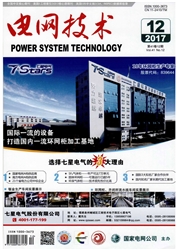

 中文摘要:
中文摘要:
对于具有同步发电机特性的逆变器,现有的小信号稳定性分析及基于小信号模型的参数选择分析中,由于建模过程中的近似及对稳态工作点变化的忽略,只能判断参数变化对小信号稳定性影响的趋势,分析结果不够准确。为此,首先建立具有同步发电机特性的并联逆变器的小信号模型,并计算特征根;确定参与因子表,分析了状态变量和特征根的关联程度。进而在计及参数变化引起稳态工作点变化的情况下,研究了下垂系数、线路参数、虚拟机参数、低通滤波器参数对系统特征根的影响规律,并对距虚轴较近的一对共轭特征根进行灵敏度分析,揭示了线路、虚拟机以及调节器等参数对该特征根对应模态的贡献度。算例仿真结果验证了分析结果的正确性。
 英文摘要:
英文摘要:
Current small-signal stability analysis and parameter selection of inverters with synchronous generator characteristics usually ignore some dynamic characteristics and steady state operating pointchanges for simplicity. It can only judge small-signal stabilitytrend and its analysis result is not accurate enough. Firstly, a small-signal model of two isolated inverters connected in parallel with synchronous generatorcharacteristics was developed in this paper, and eigenvalues of the system were calculated. Then, participation factors showing relations between state variables and eigenvalueswere calculated. Considering that operating points would change when parameter changed, several root locus plots as function of the system parameters were obtained. Individual sensitivity analysis of certain eigenvalues close to real axis disclosed different parameters' contribution to oscillation mode. Finally,simulation resultsverifiedeffectiveness of the proposedmethod.
 同期刊论文项目
同期刊论文项目
 同项目期刊论文
同项目期刊论文
 期刊信息
期刊信息
